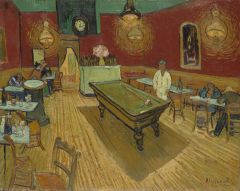![]()
![]()
![]()
Use LEFT and RIGHT arrow keys to navigate between flashcards;
Use UP and DOWN arrow keys to flip the card;
H to show hint;
A reads text to speech;
6 Cards in this Set
- Front
- Back

|
Seurat, A Sunday at La Grande Jatte, 1884 1884-1886 Post-Impressionism
Seurat was a very scientific painter, who used optical mixing to create colors that would become harmonious- this system was later called pointilism. He sought to evoke permanence by referring to the art of the past and referenced Greek and Egyptian sculpture as well as frescoes. Here he depicts modern figures of all social classes, frozen in time, though some critics thought it also served as a commentary on the posed, artificial nature of modern life. |
|

|
Vincent Van Gogh, The Night Cafe, 1888 Post-Impressionism
This painting borrows heavily in style from Japanese woodblock art. Color in this work is not memetic, instead it is used to convey theme and feeling. The tipping, alienating perspective, sickly colors and gaze of the strange patrons convey a feeling of loneliness and isolation. |
|

|
Paul Gauguin, Vision After the Sermon (Jacob Wrestling with the Angel) 1888 Post-Impressionism, Cloisonnism
This painting was also heavily inspired by Japanese woodblock art- the struggle is divided from the Breton women by an obtrusive tree trunk, the perspective is skewed and the figures are purposefully delineated by areas of flat color and dark contours.
|
|

|
Paul Gauguin, Women at the River (for Noa Noa) 1893-94 Post-Impressionism
Paul Gauguin was surprised to find that Tahiti was not the untouched paradise he had imagined, but he was greatly inspired by it and sought to convey his visionary experience of the Tahitian culture and lifestyle to his contemporaries through his project "Noa Noa," which included these woodblock prints. He was able to experiment with bold color and form. |
|

|
Paul Cezanne, Mont Sainte-Victoire 1885-1887 Post-Impressionism
Cezanne often painted from multiple viewpoints and wanted to convey permanence through his eye's different impressions. |
|

|
Paul Cezanne, The Large Bathers 1900-1906 Post-Impressionism
Cezanne's last work, perhaps a testament to a lifetime of exploring nudes in landscapes. This painting was subjected to some Freudian interpretations, which were popular at the time |

